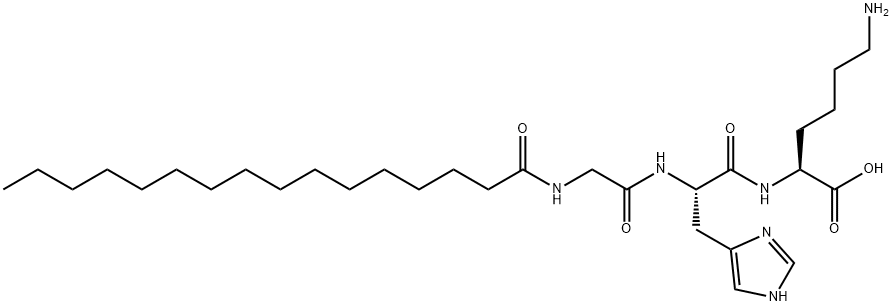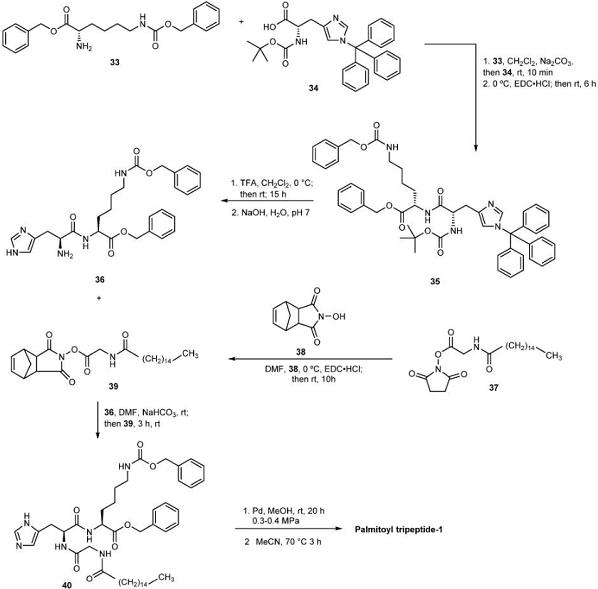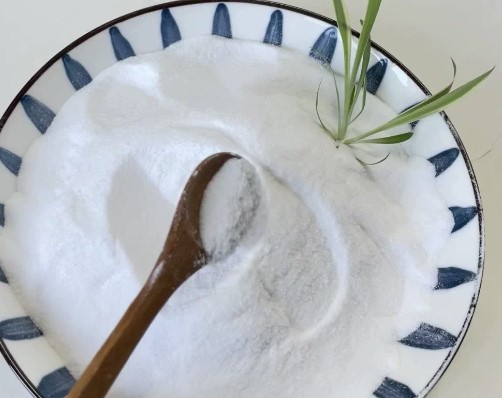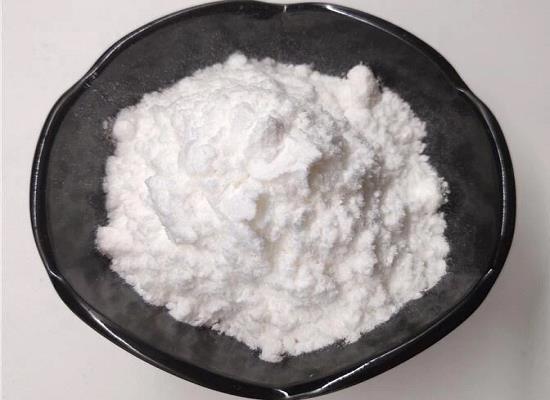Pal-Tripeptide-1: Anti-Oxidative Potential and Mechanism of Action
General Description
Pal-Tripeptide-1, a potent skin-active peptide, is renowned for its anti-aging properties in cosmetic formulations. Studies highlight its efficacy in boosting collagen synthesis, imparting skin elasticity, and reducing wrinkles without the side effects associated with Vitamin A. Noteworthy is its superior anti-wrinkle effects and antioxidant potential, surpassing well-known peptides. By stimulating collagen production and fortifying the dermis, Pal-Tripeptide-1 rejuvenates and firms the skin, offering protection against oxidative damage. This peptide's mechanism involves enhancing extracellular matrix components, resulting in smoother, youthful-looking skin with improved resilience against aging and environmental stressors. In essence, Pal-Tripeptide-1 emerges as a safe and effective ingredient for skincare products, combating aging signs and promoting overall skin health.
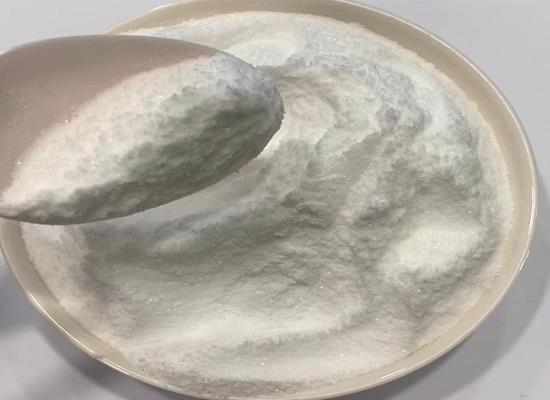
Figure 1. Pal-Tripeptide-1
Overview
Pal-Tripeptide-1, also known as Palmitoyl Tripeptide-1, is a skin-active peptide widely used in cosmetic formulations for its anti-aging properties. It is specifically designed to prevent and reduce wrinkles, tighten the skin, and improve overall skin elasticity. Studies have shown that Pal-Tripeptide-1 at a concentration of 5PPM, when combined with 0.05% Vitamin A, exhibits comparable activity to promoting the synthesis of collagen and glycosaminoglycans. Importantly, this combination avoids the potential irritations and side effects often associated with Vitamin A. One of the key advantages of Pal-Tripeptide-1 over conventional Vitamin A is its superior anti-wrinkle effects and activity without any reported side effects. This makes Pal-Tripeptide-1 a more favorable option for anti-aging skincare products. By stimulating collagen production and enhancing skin elasticity, Pal-Tripeptide-1 helps in rejuvenating the skin, making it appear younger, smoother, and firmer. In conclusion, Pal-Tripeptide-1 stands out as an effective and safe ingredient in skincare formulations, offering significant benefits in combating signs of aging and promoting overall skin health and appearance. 1
Anti-Oxidative Potential
Pal-Tripeptide-1 has been found to possess significant anti-oxidative potential based on a laboratory experiment conducted by Sakuma et al. in 2018. This potential appears to surpass the efficacy of other well-known anti-oxidative peptides such as carnosine and reduced glutathione. Through experiments utilizing an ESR spin-trapping technique, Pal-Tripeptide-1 has demonstrated the ability to reduce signals associated with hydroxyl and peroxyl radicals generated in different chemical reaction systems. These active radicals, including reactive oxygen species (ROS), reactive nitrogen species (RNS), and reactive carbonyl species (RCS), are known to cause damage to lipids, DNA, and proteins. The amino acid sequence present in Pal-Tripeptide-1 has been suggested to possess anti-glycation properties and show anti-RCS attributes against various radicals, such as acrolein, malondialdehyde, and 4-hydroxynoneal. Furthermore, Pal-Tripeptide-1 has shown promise in regulating iron release from ferritin, an enzyme involved in lipid peroxidation. Studies have reported a significant reduction in iron release from damaged tissue after exposure to Pal-GHK, indicating its potential to mitigate oxidation within affected tissues. Pal-GHK also exhibits the ability to decrease the production of reactive oxygen species and inflammatory cytokines, while enhancing the activity of antioxidant enzymes. Animal trials have shown that Pal-Tripeptide-1 can suppress the activation of NF-κB and p38 MAPK signaling pathways, leading to reduced inflammation and infiltration of inflammatory cells in lung damage. Additionally, Pal-Tripeptide-1 may alleviate oxidative stress caused by smoke inhalation. It has been suggested that Pal-GHK can elevate the expression of Nrf2, a regulatory protein involved in governing antioxidant protein expression, thereby reducing reactive oxygen species levels in alveolar epithelial cells. Overall, Pal-Tripeptide-1 demonstrates promising anti-oxidative potential through various mechanisms, making it a potential candidate for further research and development in the field of oxidative stress mitigation. 2
Mechanism of Action
Pal-Tripeptide-1 is a matrikine signal peptide that plays a crucial role in skin care. This peptide primarily acts on the dermis, the inner layer of the skin, where it effectively promotes the synthesis of extracellular matrix components such as collagen and glycosaminoglycans. This stimulation leads to an overall strengthening of the dermis, resulting in thicker and firmer skin. The mechanism of action of Pal-Tripeptide-1 involves its ability to communicate with skin cells, prompting them to increase production of collagen and other structural proteins essential for skin elasticity and firmness. By enhancing the synthesis of these key components, Pal-Tripeptide-1 contributes to a reduction in the appearance of wrinkles and fine lines, leading to smoother and more youthful-looking skin. Moreover, the peptide's influence on the extracellular matrix provides additional benefits, including improved resilience against UV radiation, which is essential for maintaining skin health and minimizing sun-induced damage. In conclusion, Pal-Tripeptide-1's mechanism of action revolves around its capacity to stimulate the synthesis of vital skin components, ultimately resulting in thicker, firmer, and more resilient skin with reduced signs of aging, making it a valuable ingredient in skincare products aimed at promoting skin rejuvenation and protection. 3
References:
[1] SCHAGEN S. Topical Peptide Treatments with Effective Anti-Aging Results[J]. Cosmetics, 2017, 4 1: 16. DOI:10.3390/COSMETICS4020016.[2] SATORU SAKUMA. The peptide glycyl-?-histidyl-?-lysine is an endogenous antioxidant in living organisms, possibly by diminishing hydroxyl and peroxyl radicals.[J]. International journal of physiology, pathophysiology and pharmacology, 2018, 10 3.
Related articles And Qustion
See also
Lastest Price from Palmitoyl Tripeptide-1 manufacturers
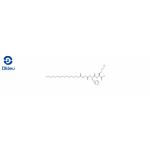
US $0.00/kg2025-11-14
- CAS:
- 147732-56-7
- Min. Order:
- 1kg
- Purity:
- 99%
- Supply Ability:
- 10000KGS
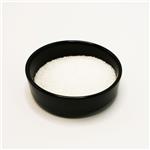
US $500.00-500.00/kg2025-10-10
- CAS:
- 147732-56-7
- Min. Order:
- 1kg
- Purity:
- ≥99.00%
- Supply Ability:
- 1000000
